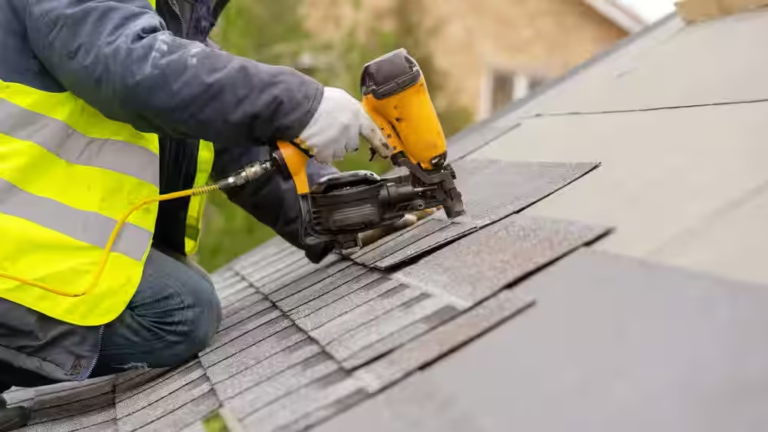So I thought I’d share what I’ve learned about handling roof emergencies after storms!
Let me tell you, there’s nothing quite like that moment when you realize your roof has been damaged during a storm. One minute you’re sitting cozy inside listening to the rain, and the next you’re grabbing buckets to catch drips from your ceiling!
We’ve dealt with this a couple times in our house, and each time I learn something new. Storms can be so unpredictable, but knowing what to do afterwards isn’t just helpful… it’s absolutely necessary.
I’ll walk you through everything we’ve learned about emergency roof repairs. Trust me, this stuff is worth knowing before you need it!
Why Storms Can Be So Damaging to Roofs
Storms really pack a punch when it comes to our roofs.
Wind is probably the biggest troublemaker. It gets under those shingles and just lifts them right up! Last spring, we had such strong gusts that I actually watched several shingles fly off our neighbor’s house. It was like they were being peeled away.
Rain seems innocent enough until it finds that one tiny spot to sneak in. Then suddenly you’ve got water stains on your ceiling and that awful dripping sound at 2 AM!
Hail is another roof nightmare. Those ice balls leave little divots and cracks all over. After our big hailstorm last year, our roof looked like it had a bad case of chicken pox.
Then there’s falling debris. We have a huge oak tree in our yard that I love for shade… but during storms? Those branches become serious problems for your roof when they come crashing down.
The scariest part is that you might not even notice the damage right away. Sometimes it takes days or weeks before you spot that telltale water stain spreading across your ceiling.
Emergency Roof Repairs To Do After Storm
When a storm finally passes, it’s time to figure out what you’re dealing with!
We’ve been through this process a few times now, and I’ve definitely gotten better at handling it. The first time our roof was damaged, I totally panicked. Now I know exactly what steps to take.
The key is acting quickly but safely. You can prevent so much additional damage if you know what to do in those first 24-48 hours after a storm.
Let me walk you through what works…
Ensure Your Safety First
Safety absolutely comes first when dealing with roof damage! This is no time to play hero.
Wait until the storm is completely over before you even think about going outside. Those calm periods can fool you… I made that mistake once and nearly got caught in round two of a thunderstorm!
Make sure the ground is stable before setting up any ladders. After one heavy rain, I set up our ladder without checking the ground first. The whole thing sank into the mud on one side when I was halfway up! Not my most graceful moment.
If your roof is steep or you’re unsure about heights, stay on the ground. My spouse is much better with heights than I am, so we have a system where I hand up tools and they do the climbing when necessary.
Always check for downed power lines before wandering around your yard after a storm. We had a scary close call with a neighbor’s line that had fallen near our driveway during a windstorm.
Your roof might be weakened after storm damage, so even if you normally feel fine walking on it, this isn’t the time to test its strength!
Conduct a Preliminary Damage Assessment
Once it’s safe, you’ll want to see what you’re dealing with.
From the ground, look for obvious problems like missing shingles, sagging areas, or debris. I keep an old pair of binoculars in our emergency drawer specifically for post-storm roof checks!
If you can safely get to your attic, grab a flashlight and look up. Any daylight coming through where it shouldn’t be? Any wet spots on the insulation? After our last big storm, I was shocked to see sunlight streaming through tiny holes I couldn’t even spot from outside.
Take tons of pictures! You’ll need these for insurance, and honestly, it’s so satisfying to look at the before and after once everything is fixed.
I also snap photos of any interior damage. Last year, we had a water stain on our hallway ceiling that grew to the size of a basketball before we could get someone out to fix the roof.
Try to figure out if you need immediate help or if it can wait a bit. Active leaks, big holes, or any structural sagging means you need emergency help ASAP!
Prevent Further Damage
Now comes the part where you minimize the damage until proper repairs happen.
For inside leaks, grab any containers you can find to catch water. During our last roof leak, I used everything from mixing bowls to the kids’ plastic toy bins! You work with what you’ve got in an emergency.
Move your furniture and valuables away from leaky areas immediately. We learned this lesson the hard way when our bookshelf got soaked during a roof leak… some of those books were never the same again.
For the roof itself, tarping is your best friend for larger damaged areas. Those big blue tarps aren’t pretty, but they’re roof lifesavers until proper repairs can happen!
We keep a couple heavy duty tarps in our garage now, along with some wood strips and nails specifically for emergency roof coverage. The first time we needed to tarp our roof, we had to run to the store in the rain… not making that mistake again!
To tarp properly, you’ll want the tarp to extend from the peak of the roof down past the damaged area. We secure ours with wood strips at the top, sides and bottom. It takes two of us working together, but we’ve gotten pretty good at it!
For tiny holes or cracks, roof cement or tape can work as a super temporary fix. It’s kind of like putting a bandaid on a roof, but sometimes that’s all you need until the professionals arrive.
Contact Your Insurance Company
Now for everyone’s favorite part… dealing with insurance! Okay, it’s not actually fun, but it’s super important.
Call your insurance company as soon as you can. I have my agent’s number saved in my phone contacts under “Roof Emergency” because I’ve needed it more than once!
Ask lots of questions about their process. Every insurance company handles things differently. Some send out an adjuster right away, others want you to get contractor quotes first.
Document absolutely everything. I created a specific album on my phone just for storm damage photos because I kept losing track of them among my thousands of family pictures.
Find out if your policy covers temporary repairs. Most do! Keep every single receipt from tarps to buckets to any emergency services you hire.
Don’t make permanent repairs before the insurance adjuster has seen the damage. We made this mistake after our first roof damage experience and had to fight to get reimbursed. Learn from our mistakes!
Find a Reliable Emergency Roof Repair Service
Finding someone good to fix your roof during emergency times can be really challenging.
Start by asking neighbors who they’ve used. After a big storm hit our area last year, our neighborhood text group became invaluable for sharing contractor info.
Be super careful about “storm chasers” who show up right after bad weather. Some are legitimate, but others… not so much. We had a guy knock on our door offering same-day roof repair at a “special storm price” who couldn’t provide a single local reference. Red flag!
Check credentials carefully! Make sure any roofer you hire has insurance and proper licensing. We always ask to see proof now before hiring anyone.
Get multiple estimates if you can. This helps with insurance and makes sure you’re not overpaying. We typically try to get three quotes before deciding.
Ask about warranties on both materials and workmanship. A good roofer should stand behind their work! We have a binder where we keep all our home repair warranties now.
Make sure their timeline works for your situation. Some great roofers might be booked out for weeks after a big storm. If your damage is serious, you might need someone who can come sooner, even if they’re not your first choice.
Conclusion
So that’s what I’ve learned about handling roof emergencies after storms!
I never thought I’d become somewhat of an expert on this topic, but after dealing with it a few times, you figure things out pretty quickly.
The most important things to remember are staying safe, preventing further damage quickly, documenting everything for insurance, and finding reliable help. I’m hoping you never need this information, but if you do, now you’ll be prepared!
We keep an “emergency roof kit” in our garage now with tarps, wood strips, nails, roof cement, and a waterproof folder with our insurance information. It gives us such peace of mind knowing we’re ready if another storm hits.
I couldn’t be happier with how much more confident I feel handling these situations now compared to our first roof emergency. Being prepared makes all the difference!



